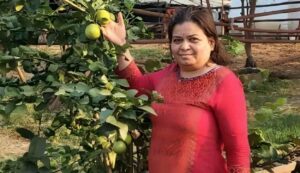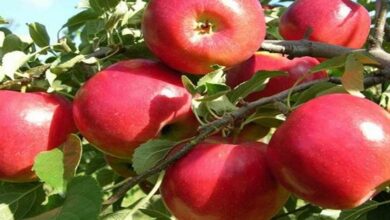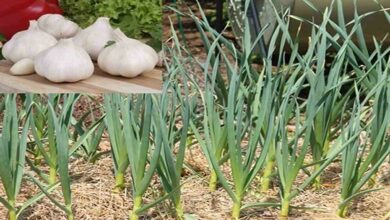Success Story: This woman from Gujarat has done wonders by doing successful natural farming, earning 5 lakh rupees annually by farming on 25 acres
Success Story: A forward-thinking farmer from Surat, Gujarat, Pruthvi Patel used to be a brilliant professor and software engineer with a steady, well-paying career. She made the decision to quit her corporate job in 2010 in order to live a more natural existence. She now promotes natural farming by enhancing her own property and motivating other farmers to use sustainable and healthful agricultural methods. Despite being a former IAS official, Pruthvi muses, “I come from a family where my father was always deeply connected to farming.” I never gave farming much attention while I was growing up since our farmhouse was more of a vacation destination.

A Life-Changing Obstacle Opens Up a New Way
She had no idea that an emotional setback in 2010 would permanently alter her life. “I had devoted myself to the demanding training year after year since I had always dreamt of entering the public services. However, in spite of my unrelenting efforts, I failed the test. I felt confused and heartbroken after that,” she says.
Pruthvi’s relatives sent her to their farm to aid in her recovery. I thought it was an escape at first, but as the days went by, something changed. I rekindle my passion for the earth when surrounded by plants, animals, and the straightforward rhythm of farm life.
A Fresh Interest in Farming
The more she worked with the land, the more she understood that farming, animals, and the natural world were her actual passions rather than pursuing a career in public services. “I discovered my purpose on the farm—to care for, develop, and coexist with the land—a goal my guru had long held dear for all Indian farmers,” Pruthvi says.
The teachings of the spiritual teacher and international humanitarian Gurudev Sri Sri Ravi Shankar, the originator of The Art of Living, have long been a source of inspiration for Pruthvi. Over 30 lakh farmers have received natural farming instruction thanks to Gurudev’s relentless efforts to provide them with both financial and holistic aid. Both the farmer and the customer benefit from this agricultural method, which also has almost no input costs and helps the planet recover from the assault of pesticides.
A Transition to Natural Agriculture
The Art of Living’s Sri Sri Institute of Agriculture Science & Technology Trust gave Pruthvi the chance to plan and participate in the Panch Mahabhut Kisan Sammelan in Gujarat in 2010. It was then that Gurudev Sri Sri Ravi Shankar introduced me to natural farming. His vision motivated me to begin advocating for green agricultural methods,” she remembers.
Pruthvi enrolled in an Agriculture Teacher Training Course (TTC) at the Sri Sri Institute of Agricultural Sciences & Technology (SSIAST) because she was determined to learn more. In order to comprehend the crucial function that cattle play in organic farming, she also spent time in a gaushala, or cow shelter. She started laying the groundwork for her farm despite having no official agricultural training since her determination was strengthened by her experiences at the local level. Her newly discovered route was guided by the patience, resiliency, and connectivity she had acquired on the farm.
She managed a 25-acre farm in Navsari that flourished without the use of chemical pesticides, herbicides, or fertilizers by 2014, demonstrating her full commitment to this new way of life. Her farm utilizes a mixed cropping system, combining agriculture and horticulture in a chemical-free method that emphasizes the workings of nature.
Making the Switch to Natural Farming
But Pruthvi’s path wasn’t without its challenges. Unlearning traditional chemical-dependent agricultural methods was necessary to make the switch to chemical-free farming. Her father, who had been farming for decades using conventional methods that weren’t the healthiest or most lucrative in the long term, was particularly skeptical of her decision to not depend on synthetic inputs. Additionally, local farmers questioned if natural farming was the way to long-term financial success. One of the main obstacles was restoring the soil, which had totally degraded as a result of the heavy use of chemical pesticides and fertilizers.
Restoring the Health of the Soil
Pruthvi used a mix of mulching, compost, and cow dung manure to revitalize the soil. Her farm’s success demonstrated the effectiveness of these techniques as the soil gradually recovered and output increased. “Our objective was self-sufficiency—removing the need for expensive fertilizers or chemicals—rather than financial gain. By using natural ways and producing cows, we were able to save around Rs 5 lakhs a year on our 25-acre farm. Pruthvi said with delight, “It was a significant cost reduction made possible by low-budget practices like improving soil health rather than investing in expensive technologies.”
Educating Workers and Obtaining Assistance
Training local workers who were not accustomed to natural farming was another significant obstacle. It required time and effort to find employees who were ready to adjust on a regular basis, even in the absence of supervision. She gradually gained the support of her family once they saw how dedicated and committed she was to natural farming. Nonetheless, some elderly farmers remained resistant to change; some were critical, while others questioned the efficacy of these strategies. However, the outcomes were self-evident.
Comprehending Natural Farming Methods
Natural farming, according to Pruthvi Patel, is an integrated agricultural method that is sustainable, chemical-free, and relies on natural resources to thrive. This farming approach avoids plowing and tilling, which disturb the microbial life, structure, and composition of the soil, and instead uses multi-cropping, cow dung and urine-based manure, natural pesticides, cropping in accordance with the region’s natural cropping seasons, and water conservation. To keep the soil healthy, methods including limited tillage and direct sowing are used.
Enhancing the Health and Yield of Soil
Our soil quality has greatly increased since we switched to natural farming; my land’s carbon to nitrogen ratio is now 1.6, which is perfect for farming. This was the result of three years of constant use of natural agricultural practices. Better yields, stronger crops, fewer pests, and a flourishing local environment with more biodiversity have all been seen. After bringing Desi cows to the farm, I saw a significant change from my humble beginnings in horticulture. There hasn’t been any going back since that pivotal moment! She clarifies.
Creative Pest Control Using Natural Techniques
According to Pruthvi, natural farming uses the environment to control illnesses and pests. Cow urine from Desi cows, which has antiviral, antibacterial, and antifungal qualities, is a crucial remedy. It helps with pest control in addition to its medical uses. Additionally, to shield crops from insects and fungal illnesses, herbal formulations such as neem leaves—which have been scientifically demonstrated to be effective in managing pests—are created and sprayed in a methodical manner.
She goes on to say that since natural farming maintains soil health, lessens reliance on chemicals, and fosters biodiversity, it is essential for sustainability. Many farmers are switching to natural farming practices in search of higher yields, healthier crops, and a more sustainable future as a result of rising knowledge of the long-term dangers of chemical farming.
Exchanging Information and Motivating Change
The influence Pruthvi has had on other farmers has been one of the most rewarding parts of her career. She now shares her experiences and mentors anyone who wants to embrace chemical-free methods via seminars and field demonstrations. She has worked with the Sri Sri Agriculture Science & Technology Trust to teach natural farming to thousands of farmers, spreading the practice across Gujarat.
Prospects for the Future
She has a clear vision for India’s agricultural future: one in which traditional knowledge and cutting-edge technology coexist to improve biodiversity, restore soil health, and guarantee food security. She sees farming as a respectable and successful career path for young people, particularly women. She supports improved market connections for natural products, farmer education initiatives, and more robust legislative support in order to realize her ambition.





